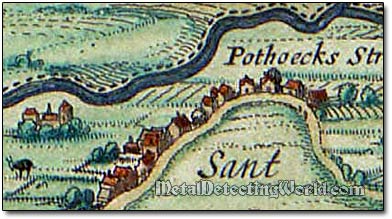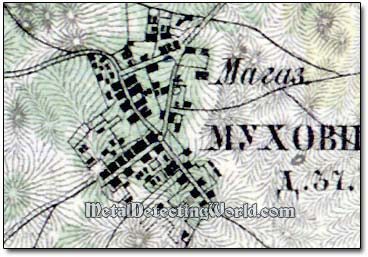Metal Detecting Research and Exploration - A Complete Guide, page 11
Map Research for Locating Treasure Hunting Sites in Europe
IMPORTANT SPECIFICS
(CONTINUED from Page 10)
Most of the villages in the Russian North-West have been of a linear-settlement type. A linear village - is a settlement formed around a transport route, such as a road.
A 1624 Lithograph Fragment Shows a Village of Linear Type

A linear village could have no obvious center, such as a road junction or green, and often it was only a single street with houses on either side of the road. Later development may add side turnings and residential plats away from the original main street.
A Map Fragment Shows Two Villages of Linear Type

As many villages had been reduced in size for numerous different causes over the centuries, their linear shapes had become considerably shorter in length by now. The former end-points of any old and still existing village are just empty and abandoned spots. From my own metal detecting experiences, I can assure you that these village-ends have hidden many treasures!
A linear village is in contrast with a ribbon type settlement - the outward spread of houses along transport routes radiating from a human settlement. The metal detecting sites of the ribbon type settlements are very rare in the eastern Baltic Sea region. However, their sites can be indicated by the junctions of a few abandoned roads shown on both old and modern maps.
A Map Fragment Shows a Village of Ribbon Type

At last, it is important to mention that many settlements that are marked as villages on the 17th and 18th century maps may consist of just one or two homesteads instead of many to be expected. For instance, the single-homestead villages comprised 66% of all settlements in one district of Ingermanland at the end of the 18th century. This phenomenon can be explained by:
1) Contemporary definition of a village by surveyors
During the serfdom period, if the homestead was assigned a parcel of arable land, the surveyor considered it to be a village, thus, if the dispersed settlement was comprised of a few homesteads owned by different estates, each homestead was marked as a village in the Land Register Book (described on page 14). In the 16th century, the surveyors started defining a dispersed settlement as a village in terms of an economic unit, not a geographical one, when a few homesteads in a settlement were assigned one common parcel of land. The individual homesteads still continued to be marked as villages on maps.
2) Effects of previous wars
The increase in war conflicts, which occurred from the late 16th century to early 18th century, caused a massive "shrinkage" of villages, if not their complete disappearance. There were fewer peasants who survived the military havoc in each village, and they had no enough man-power nor resources to rebuilt a settlement of the former size. Historically the single-homstead villages were the majority of settlements due to other causes described on the following pages.